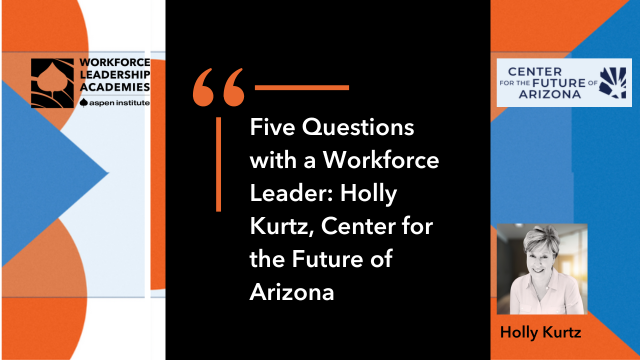Holly Kurtz
Director of Workforce Development
The Center for the Future of Arizona (CFA)
Holly Kurtz, director of workforce development at the Center for the Future of Arizona (CFA), has led teams delivering Workforce Leadership Academies (WLA) in both Phoenix and Southern Arizona. In this Five Questions, Holly shares her perspectives on leadership development and talent development for the workforce field, building upon 36 years of experience in human resources in the private sector.
Tell us about your background and how that experience contributed to your workforce development work at CFA and as a WLA Facilitator.
I worked in senior human resources (HR) roles for 36 years in banking and retail, at Wells Fargo & Company and PetSmart, focused on talent management including accountability for leadership development. I joined Center for the Future of Arizona in late 2016 to lead the workforce development initiatives, in particular focused on the retail sector.
My past experience positioned me well to focus on improving talent retention and upskilling strategies with employers, introduce job quality frameworks and strategies, and integrate DEIB (diversity, equity, inclusion, and belonging) into talent management activities. The transferability of my corporate HR work to the workforce development ecosystem was a natural transition.
Why is it important for CFA to be involved in an effort like Workforce Leadership Academies?
Center for the Future of Arizona’s mission is to create a stronger and brighter future for our state. We have a focus on Education, Civic Health, and Workforce Development. Our strengths at CFA are to connect, convene, collaborate, and catalyze action to create systems change. We use data to identify insights and provide meaningful information to move Arizona forward. When hosting our first Workforce Leadership Academy was proposed in 2022, we knew this was a great way to fill an unmet need in the workforce development ecosystem around professional and leadership development for Arizonans who worked in that sector.
In their September 2023 blog, Sheila Maguire and Dee Wallace shared the perspective that workforce development professionals and leaders were like the “cobbler’s children who had no shoes.” What are your thoughts on this perspective?
I used to say that human resources professionals were the shoemaker’s children that didn’t get shoes because we didn’t invest in developing HR talent to attract and retain them — and yet, they were the ones who did that for everyone else in an organization. It’s the same with workforce development professionals. We haven’t invested in their development — in particular, leadership development — and yet, they support unemployed and underemployed individuals through training, upskilling, internships, and apprenticeship programs sponsored by workforce boards, community-based organizations, and community colleges.
That’s why when CFA had the opportunity to host a Workforce Leadership Academy, we were so excited to find a curriculum and model that enabled us to invest in the leadership capabilities and capacity of workforce partners in the Greater Phoenix region. Through the Academies, we were able to expose a cohort of fellows to systems thinking, change management, new mental models, and national speakers, as well as support the development of their leadership skills. Then, in partnership with Pima Community College, we were able to expand the impact of this model in 2023 when we hosted the Southern Arizona Workforce Leadership Academy.
What is your reflection after facilitating Workforce Leadership Academies in Phoenix in 2022 and in Southern Arizona in 2023?
My passion has always been leadership development. My experience tells me that changes in a system start with leadership, and the workforce development ecosystem is ripe for innovative changes at all levels — on the ground, in communities and regions, and with policies. These academies have reinforced my belief that progress and positive change are not only possible but also achievable through incremental steps, long-term commitment, and the right support tools. With the ability to come together, leaders can drive meaningful impact and foster a brighter future for our workforce.
Are there any developments in the workforce field and the labor market that are exciting to you?
I’m very excited about the good/quality jobs “movement” that is occurring across the country, led by organizations like the Aspen Institute, Jobs for the Future, the National Fund for Workforce Solutions, the Families & Workers Fund, and others. The talent imperative for employers around attraction and, more importantly, around retention is critical. The good/quality jobs concept, framework, and tools can help employers with a way to address that talent imperative. The challenge is that those of us in workforce development need to not use models and jargon around good/quality jobs when we’re talking to employers. Employers want answers and actions, so we need to ensure we are talking in terms that employers understand and can implement. This concept was one I embraced working in the private sector as a human resources leader — it just didn’t have the title of good/quality jobs.
We are grateful to Holly Kurtz and her partnership with the Workforce Leadership Academies and appreciate all that we continue to learn from her and CFA about supporting leaders and practitioners who are opening doors to economic opportunity. For more information about the Center for the Future of Arizona, visit arizonafuture.org



